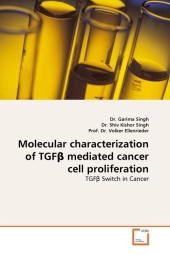 Neuerscheinungen 2010Stand: 2020-01-07 |
Schnellsuche
ISBN/Stichwort/Autor
|
Herderstraße 10
10625 Berlin
Tel.: 030 315 714 16
Fax 030 315 714 14
info@buchspektrum.de |

Volker Ellenrieder, Garima Singh, Shiv Kishor Singh
(Beteiligte)
Molecular characterization of TGF mediated cancer cell proliferation
TGF Switch in Cancer
2010. 100 S.
Verlag/Jahr: VDM VERLAG DR. MÜLLER 2010
ISBN: 3-639-29801-2 (3639298012)
Neue ISBN: 978-3-639-29801-7 (9783639298017)
Preis und Lieferzeit: Bitte klicken
TGF has a dual role in carcinogenesis, acting as a growth inhibitor in early tumor stages and a promoter of cell proliferation in advanced diseases. Although this cellular phenomenon is well established, the underlying molecular mechanisms remain elusive. Here, we report that sequential induction of NFAT and c-Myc transcription factors is sufficient and required for the TGF switch from a cell cycle inhibitor to a growth promoter pathway in cancer cells. TGF induces the expression and activation of NFAT factors, which then translocate into the nucleus to promote c-Myc expression. In response to TGF , activated NFAT factors bind to and displace Smad3 repressor complexes from the c-Myc promoter. c-Myc in turn stimulates cell cycle progression and growth through up-regulation of D-type cyclins. Most importantly, NFAT knockdown not only prevents c-Myc activation and cell proliferation, but also partially restores TGF-beta-induced cell cycle arrest and growth suppression. Taken together, this study provides the first evidence for a Smad-independent master regulatory pathway in TGF -promoted cell growth that is defined by sequential transcriptional activation of NFAT and c-Myc factors.


